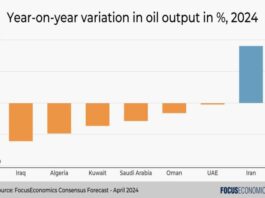
By Terrence R. Blackman, Ph.D.
Guyanese have produced sugar for 15 generations. First cultivated in 1658, Guyanese planters started producing sugar commercially in the late 1700s, 100 years after their counterparts in the West Indies.
Because of Guyana’s late entry into the sugar industry, they imported relatively advanced milling sugarcane equipment. This advanced equipment investment gave the Guyanese sugar industry a secure foundation and made it the Guyanese economy’s leading sector.
The Guyana Sugar Corporation, Guysuco, is the country’s largest cultivator and producer of sugar. Guysuco is responsible for approximately 10-15 percent of Guyana’s annual revenue and almost 40 percent of all agricultural production.
Sugar production has declined by almost 150 thousand metric tons from 2002 to 2016. This decline in production has resulted in annual losses that reached USD$85 million in 2014. These ongoing losses have necessitated large injections of financial support from the government to maintain the organization’s liquidity.
Guysuco, currently configured, is economically unsustainable. However, much of Guyana’s culture and industrial capacity is linked to the sugar industry. Guyanese policymakers must diversify and add value to the range of sugar production products. We must move beyond sugar, rum, and molasses to ethanol and energy. It is the energy potential of the sugar industry that offers the most viable path forward.
A consistent, long-term supply of lower-cost Guyanese energy is the key to creating a 21st-Century Guyanese economy characterized by high-paying jobs.
Lower electricity and fuel prices will spur Guyanese prosperity. Domestic energy resources development is the basis for a clean energy portfolio that optimally balances Guyana’s fossil and renewable energy sources.
Sugarcane offers an essential source of renewable energy and bio-based materials. The sugar estates are precisely the industrial sites that ought to be integrated with the emerging oil industry. Guyana should use oil revenues to invest in renewable, bio-based energy technologies to repurpose its sugar industry as a part of the Guyanese renewable energy sector. Innovative technologies show promise to safely and efficiently harness Guyanese power from its sugarcane resources.
Brazil’s experience illustrates how sugarcane has gone from being a single commodity resource to a flexible and diversified renewable resource. Brazil generates approximately 7 percent of its electricity from sugarcane biomass, and there is a clear opportunity for expanding bioelectricity production in the country even more.
A recent study conducted by the Sugarcane Renewable Electricity Project (SUCRE) estimated the current additional power potentially stored in the Brazilian Center-South region. This region accounts for 93 percent of the total sugarcane processed in Brazil. The results showed that when considering the use of 50 percent of the straw already available in sugarcane fields, an additional 35 Terawatt-hour (TWh) could be exported to the Brazilian grid yearly, with a potential to supply electricity to about 28 million households in the country.
The development of modern bio-refineries using sugarcane will allow for innovative combinations of value-added products and services from agricultural and industrial sources to ensure efficient and effective use of sugarcane resources to support sustainable development pathways in Guyana. Bioelectricity from sugarcane straw can be economically integrated into the Guyanese energy sector, even considering the various challenges, to achieve a cleaner energy matrix in Guyana.
In 1800, there were an estimated 380 sugar estates along the coast. Today, two centuries later, the Guyanese population is still concentrated on this same coastal strip of land, and sugar is still one of the nation’s most valuable products.
Guyana is a sugar cultivation colony.
As plantations expanded, to supply the labor required for sugar cultivation, plantation owners imported, from West Africa, thousands of enslaved Africans each year. By the 1830s, more than 100,000 Africans were working in the colony.
The British took full control of Guyana in 1814, and in 1833 when Britain passed the Act for the Abolition of Slavery throughout the British Colonies, Guyana’s sugar economy fell into turmoil.
The law provided a five-year transitional period during which plantation owners were supposed to begin paying soon-to-be- freed enslaved Africans for their services. In practice, plantation owners alienated the enslaved Africans by wringing from them as much work as possible during the last years in bondage. Upon emancipation in 1838, almost all of the formerly enslaved Africans abandoned the plantations.
Agricultural production plummeted. Some former enslaved Africans bought failed plantations, but many lacked the capital to reconstruct the complex operations after years of neglect. Most Africans reverted to subsistence farming. By 1848 only 20,000 Africans worked on sugar estates.
Today, more than 40 percent of Guyana’s post-independence population descend from enslaved Africans who came to work on the sugar plantations.
Faced with the prospect of complete extinction of the sugar industry, plantation owners looked abroad for laborers. Indentured servants typically contracted to work for five years in exchange for a one-way passage to Guyana, food and housing were the solutions to the labor problem.
After taking on indentured servants from Portugal, China, and the West Indies, plantation owners turned to what would become the most important source of immigrants: India.
In all, the British brought about 240,000 indentured East Indians to Guyana between 1838 and 1917 when the authorities ended the indentured labor program.
Most East Indians remained in Guyana after completing their indenture terms. Their descendants account for about half of Guyana’s population today. Guyana’s history and her destiny is inextricably linked to the fortunes of the sugarcane plant.
Brazil’s path in this sector is an example that can guide Guyana. Brazil has developed a sugarcane industry that is versatile and capable of meeting different demands. It can produce ethanol for fuel, alcohol for disinfection purposes, and sugar for domestic and international markets. Brazil stands out from other countries as 85 percent of their plants can produce sugar and ethanol, thus optimizing production.
Repurposing the Guyanese sugar industry around renewable energy can reconnect, reintroduce, and reintegrate both the African Guyanese and Indian Guyanese to the Guyanese society’s foundation and provide Guyana with a consistent, long-term supply of lower-cost Guyanese energy that is the key to creating a 21st-Century Guyanese economy characterized by high-paying jobs.



